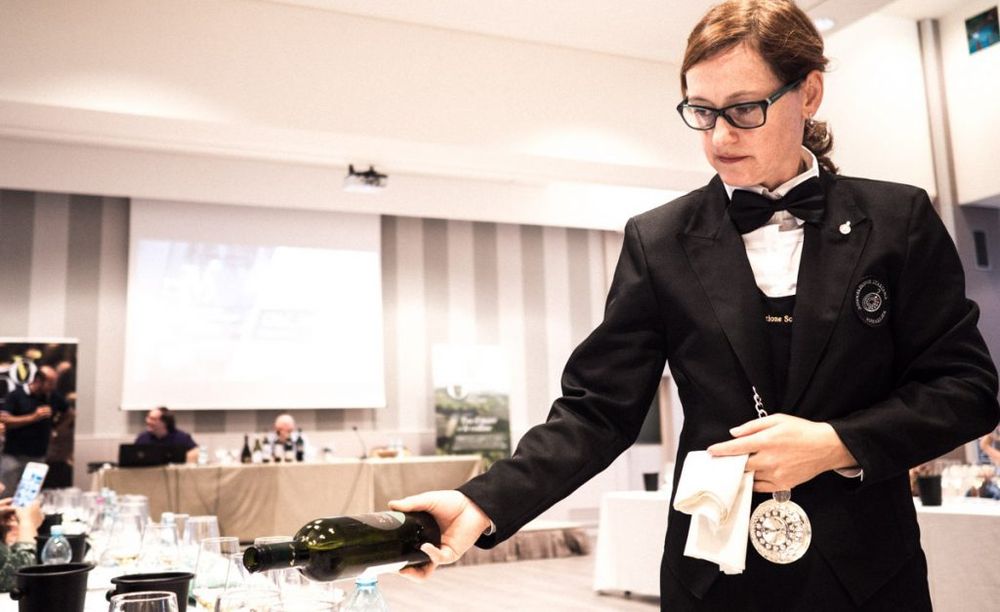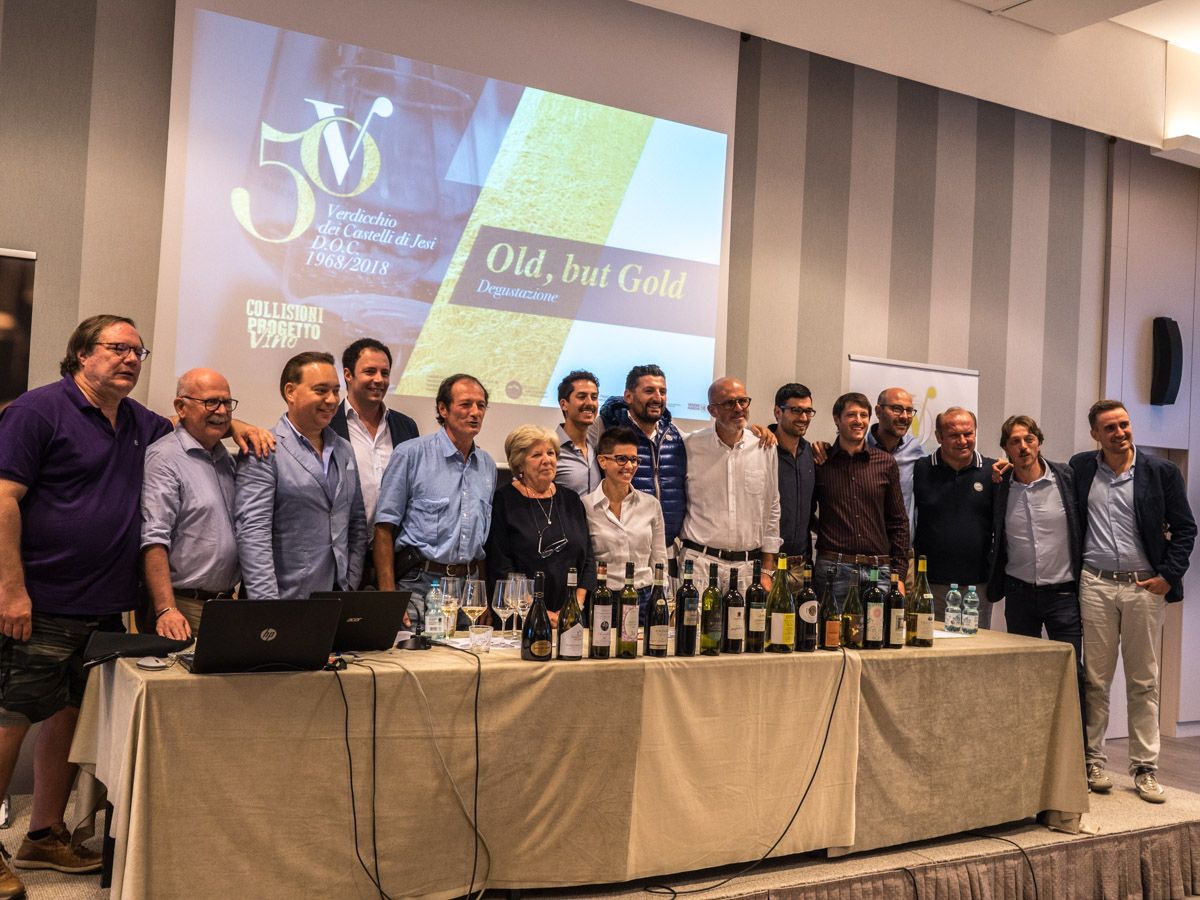Italian whites are very much in demand across the on-trade, but price points tend to be nearer the house wine level. But they don’t have to be, says Anton Moiseenko.
Why is it always the same story with Italian white wines: they – with rare exceptions – are perceived as something not worth cellaring. “Come again?” – the snobs would say. But these are the varieties that Italian noblemen were happy to drink, so why wouldn’t we get past our doubts and dive into the world of grape varieties that carry the name “Classico” on the label (and there are not so many in Italy).
Particularly when you meet the winemakers that are rolling out 10-year-old wines (and more), which in the case of Verdicchios from the area of Jesi makes 10 year old wine the bare minimum.
The recent “Old But Gold” tasting of older Verdicchios of Marche, the region where mountains date the sea on a regular basis, proved once again that in the right “golden” hands every grape gets a chance. Add some historical terroirs, like those around the town of Jesi to the mix, and you can’t help praise the winemakers’ efforts.

The tasting attracted sommelier, buyers and experts from around the world
Celebrating Verdicchio
I was lucky enough to have been invited to the memorable “Old But Gold” tasting with wine consultant and Italian specialist, Ian d’Agata, as part of a three days of Verdicchio tasting, where sommeliers, trade buyers and MWs from all around the world gathered to discover the true potential of the white “king” of Marche – the Verdicchio variety.
Not one of the 15 still wines presented for the tasting failed to serve its minimum purpose – to be a pleasant and drinkable wine. As we proceeded from younger vintages (2014 having been the youngest) to the older ones (the tasting peaked at 1997), it was clear to see the potential of Verdicchio terroirs.
While most Verdicchios are consumed younger than four years old, that’s where we started with a four year old bottle fromTenuta dell’Ugolino. The 2014 presented the exotic side of the variety, bright, rich and cheerful, aged in stainless steel and showing an intense attack on all the senses. Pineapple and yellow apple packed tightly.
A five year old Leopardo Felici’s “Vigna Il Cantico della Figura” 2013 is a rather crispy, but overall modest Verdicchio with playful astringency and a pleasant exotic finish. While very nice wines in their own right both 2014 and 2013 can lead to a false belief that Verdicchio is all like that: exotic and bright. The wines that came later demonstrated that one couldn’t be more wrong.
Next up was the eight year olds. Tenuta di Tavignano “Misco” 2010, Casalfarneto “Crisio” 2010 and Montecappone “Utopia” 2010were the three Riserva wines chosen. These were wines that showed Italian whites can withstand eight years of ageing. The “Misco” 2010 was beautiful and balanced, and showed the increased pungency and the growing complexity of aged Verdicchio.
Casalferneto’s Verdicchio “Crisio” was, on the other hand, a deeper, lingering, rounded wine arguably injected with gunpowder – the taste we would discover in many fine older Verdicchios to come. The Montecappone “Utopia” 2010 Riserva showed a modest character affected by a cold vintage on clayish soils.

The ‘Old But Good’ tasting was a chance to see how well Verdicchios can age
Big surprises
The real surprises were yet to come, though.
The 2009 “Rincrocca” by La Staffa pushed the limits of what you would expect from Verdicchio. Who could know a nine year old white from Marche could be like that? Deep, salty, lush, peppery and mineral at the same time? Again, the gunpowder aromas showcase the character of the soils and grape combination that comes from clayish-calcium salty soils in the hills near the small village of Staffolo.
Moving on to 10 years old wines – “Selezione Gioachinno Garolfoli” from the Garofoli winery showed a good acidity with already familiar notes of gunpowder. On the other hand, the Marotti Campi “Salmariano” 2008 was fresh as new, pleasantly pungent, beautifully saline and very attractive overall. It didn’t lack complexity too, making some of us to think about it enormous potential as a food wine.
Both Santa Barbara’s “Stefano Antonucci” and Umani Ronchi’s “Plenio” 11 year olds showed really well and again testimony to what excellent aged Verdicchios can achieve. With Umani Ronchi being more on the “classic” side (i by this I mean a rounder style), beefier and juicer, the Santa Barbara was a stream of mind-blowing acidity mixed with stellar minerality and a familiar gunpowder take.
A 14 years old Pievalta was definitely one of the favourites of the tasting: the Riserva “San Paolo” 2004 is amazingly deep and bright, lingering on the palate and revealing tons of pungency, the wine of definite gastronomic power and, dare I say, scientific interest.
How old can they go?

The tasting line up
How much better and how much older Verdicchios can really be? That was the question as we moved on to tasting 17-18 years old wines. Fazi Battaglia’s “San Sisto” Riserva 2001 was in surprisingly good shape, despite having probably lost some of its initial freshness, the wine retained the body with clear vanilla hint.
Another 17-year-old wine — Coroncino’s “Gaiospino” 2000 was a staggering wine with great depth, nutty character that, nevertheless, retained all of its beauty, complexity and brisk acidity, with good body weight and powerful richness. Frankly, the old Verdicchio is as modern as any hipster would like it to be!
Was it enough to put Verdicchio into a different league? Well the best was yet to come. A 20 year old “Vigna Novali” 1998 from the cooperative winery of Terre Cortesi Moncaro was the Verdicchio that reminded me of visiting a pharmacy. The wine was balanced in the mouth and whilst not showing the amazing structure of the previous one, it still delivered great emotions.
Then to the final wine: Fratelli Bucci, “Villa Bucci” 1997. Considering its age this Riserva could be in any shape from beautiful to horrible. And it was a stellar wine: lingering in the mouth, buttery like some Burgundies and showcasing deep, juicy salinity. At 21 years old, the legal drinking age in some countries, this wine would be a great start for anyone’s drinking career. A cherry on top of the tasting cake, it was testimony to the Marche’s (and Jesi’s) potential, and proof for each and every sommelier in the world and an attraction for a collector’s wallet.
































